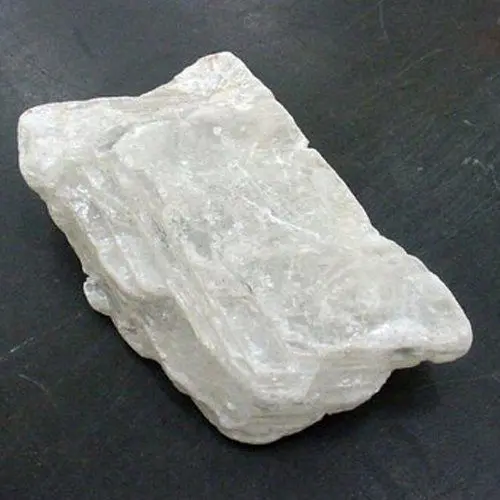What is Gypsum?
Gypsum is a soft sulfate mineral composed of Calcium sulfate dihydrate (CaSO4:2H20). It is widely used as a fertilized, in mould, in sculptures and as plaster material.
Gypsum is a chalk like material and is very light in weight. It is available in crystalline form in nature.
In recent years, the construction sector has witnessed a number of new trends, technology advancements and innovations across applications, all aimed at making construction faster and delivering higher performance.
Gypsum although a much older material than the cement & sand plaster has rarely been used extensively in construction industry. Now a days, Gypsum has proved to be a miraculous material aiding interior construction due to its properties.

What is Plaster of Paris?
Plaster of Paris is obtained by pulverizing the gypsum (calcium sulphate hemihydrate CaSO4 0.5H2O) which is heated to a temperature of 150 deg centigrade.
Upon addition of water, Plaster of Paris (POP) becomes regular gypsum (dihydrate) again causing the resultant material to harden. This hardening material can be used to create moulds for casting and in construction.
https://youtu.be/VGQElXJ4qGo
What is Gypsum Plaster?
When dry POP powder is mixed with water it hardens. This material which can be applied over brick, block or concrete surface to form a smooth surface is called gypsum plaster.
Earlier, a 6 mm coat of gypsum plaster (termed as POP punning) is usually applied on the top of cement plaster to give a smooth finish to it before painting. This is a two stage process and involves various elements like sand, cement and water which has to be mixed onsite. This process is slowly being replaced by a direct application of single coat of gypsum plaster. In gypsum plaster, readymade POP powder is mixed with water and applied directly on the wall.
Gypsum Plaster can be applied directly on any brick, solid or hollow blocks, AAC blocks and plaster boards. Gypsum plaster has good insulation properties, fire resistant and impact resistant. Also, gypsum saves a lot of time during construction and has superior finish. These properties have clearly drawn attention of real estate builders and contractors towards choosing gypsum plaster over traditional cement plaster.

Also Read : How to Apply Gypsum Plaster on Wall for More Information on Surface Preparation, Application Procedure, Finish etc.
Technical Specifications of Gypsum Plaster
Colour of Finished surface: White
Setting Time: 25-30 Minutes
Coverage area (considering 12mm thickness): 21 sq.ft per 25 Kgs Bag
Compressive Strength: 60-70 kg/cm2
Shelf Life: 4 Months
Advantages and Disadvantages of Gypsum Plaster
Advantages of Gypsum Plaster
Contractors and Builders started preferring gypsum plaster instead of due to its superior finish and time saving attributes. Some of the advantages of gypsum plaster are:
- Ease of Application (Workability): Gypsum can be directly applied over brick/block work without separate finishing. It is also very easy to apply and level gypsum plaster.
- No Shrinkage Cracks: Gypsum reaction produces less heat as compared to cement reaction with water. So there are fewer Shrinkage cracks in gypsum plaster as compared to traditional cement plaster
- Quick Setting Time: Gypsum sets quickly (i.e., within 25-30 mins). So painting could be started 72 hours after application of gypsum plaster. Plaster has to be dried up before painting.
- No curing time required: Unlike Traditional Cement Plaster, Gypsum plaster doesn’t need any curing saving water and time during construction
- High Productivity: Reduces time considerably when compared to conventional cement plaster
- High Performance: Excellent high strength after drying, Durable and Light weight (Reduces dead load on structure)
- Smooth Finish: Perfectly lined, levelled, smooth walls and perfect right angled corners
- Reduced Supervision: Careful quality checking is required for cement plaster as cement and sand has to be properly proportioned. In contrast, gypsum plaster doesn’t require same amount of quality checks for application thus reducing supervision efforts.
- Readily available raw materials: Gypsum is a ready available material. Natural Sand, which is a raw material used in Traditional cement plaster, is hard to obtain. It is also banned in multiple states in India
- Fire resistant:Gypsum plaster is highly resistant to fire
- Low thermal conductivity: Gypsum has low thermal conductivity. This saves electrical cost for heating and cooling rooms in a building.
- Decorative application: It can be easily applied to decorative purposes also and can be mould into different shapes
Disadvantages of Gypsum Plaster
- Gypsum plaster cannot be used for outside walls since they retain dampness. Also gypsum plastering cannot be done in areas which are continuously damp such as bathroom etc.,
- Gypsum plaster is costlier than traditional cement motar plaster (cement and sand) for same thickness of plaster. But in areas where natural/river sand is not available for construction, cement mortar plastering would require a 6 mm gypsum layer to finish it making cement plaster more costly.
Storage of Gypsum Plaster At Site
Exposure to water or moisture reduces the setting time and strength of gypsum plaster. So gypsum has to be stored properly.
- Gypsum Plaster (POP) bags has to be stored on elevated surface (dry platform) made of bricks/timber/concrete at site.
- The minimum shelf life of Gypsum Plaster 3-4 months from the date of manufacture. But if properly stored gypsum can be use in excessive of 6 months subject to temperature and humidity.
Read on How to Properly Apply Gypum Plaster on Walls? For details on surface preparation, application procedure, finish recommended and top brands available in the market.





